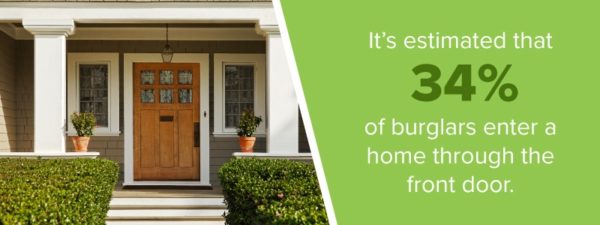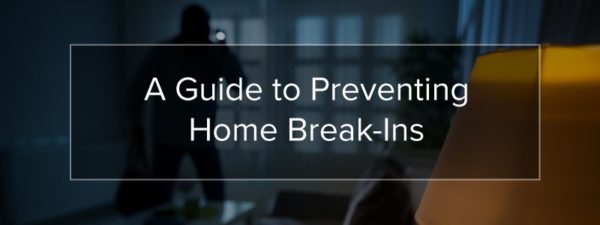
Home is a sanctuary. It’s where we spend our most cherished moments. It’s where we raise our families. It’s where we dream of our futures.
Unfortunately, a break-in or burglary not only robs us of our possessions, but it also robs our homes of the feeling of security that we hold so dear.
According to the FBI, there were over 2 million burglaries in 2010, which accounted for 23.8 percent of property crimes that year. Of those burglary offenses, 73.9 percent were committed against residences.
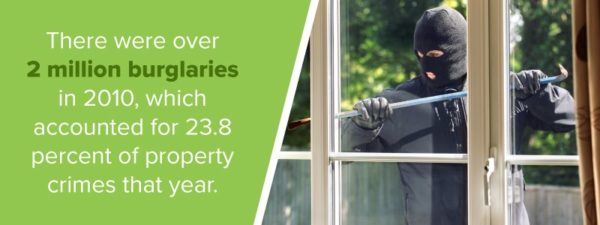
As such statistics indicate, burglaries in the United States are all too common.
That’s why it’s so important to be familiar with the best practices on how to protect your home from burglary. With that in mind, here is our guide on how to prevent home break-ins. Here, we’ll discuss how to stop burglars from targeting your home and how to protect your home from theft if they do.
So keep your home and family safe and secure. You deserve a sanctuary from all the stresses of life, and protecting your home from burglary will eliminate one source of stress that nags all too many of us.
Pinpoint the Sites of Break-Ins
One of the best ways to protect your home from a potential break-in is to understand where burglars are most likely to enter. By pinpointing and then focusing on the most commons points of entry, you can increase your defenses strategically.
- The Front Door: The most common approach for burglars is the same one used by your guests. It’s estimated that 34 percent of burglars enter a home through the front door. It’s important that you take proper security measures designed to prevent unwanted entry through your front door.

- First Floor Windows: After the front door, windows are the next most common entry point for thieves. Window-entry burglaries account for 23% of break-ins.
- Side Doors: Side doors just barely trail windows, accounting for 22% of break-ins. Sliding glass doors are especially common among side-door burglaries.
- Garages: Increased standard security measures on garage door installations have drastically reduced the number of garage break-ins, now only accounting for 9% of total burglaries.
- Basements: Many homes don’t have exterior basement entries, a fact that lowers the percentage of basement-entry break-ins. While they may only account for 4% of total burglaries, know that a thief will still be eager to take advantage of a poorly-secured exterior basement or bulk-head style door.
- Second Floor Windows: Depending on the style of your home and roof, second-floor windows may be more easily accessible than in other homes. Therefore, while only 2% of burglaries involve entry through a second-floor window, if you have such windows that look out over an easily accessible section of the roof, you may be leaving a tempting target for a perceptive thief.
Of course, pure statistics don’t determine the specific risks of your particular home. Architecture and design will also have a huge impact on where a burglar might target your house.
However, the statistics listed above do give you a sense of the mind of the typical thief. They’re going to take the path of least resistance and therefore will most commonly check your front door before exploring any other options. While sophisticated thieves will work hard to investigate potential weak spots in your defenses, most would-be thieves will check easy access points and move on if they look to be sufficiently secure.
Use Common Sense
While there are many security devices and measures that you can install to prevent or thwart break-ins, there are also some common sense steps you can take that don’t cost a thing and require zero installation.
- Keep valuables — especially small items like jewelry — out of sight of windows. Not every thief is scoping a house for weeks in advance. Many would-be burglars are simply walking by without the intention of breaking in. However, when presented with what appears to be an easy crime of opportunity, they may attempt a “smash and grab,” taking advantage of easy and quick access to valuables with no concern for sneaking in unnoticed. So store your small valuables out of sight. Similarly, don’t leave valuable small electronics, such as tablets and laptop computers, in easy view of your windows, especially when no one is home or overnight.
- Don’t discuss daily routines with strangers. Consider this scenario. You regularly walk your dog when you meet a stranger on the street who appears to be interested in your pet. They start to ask you about your dog routine while also fishing for information on whether anyone else lives in your home. What may at first feel like a friendly conversation with a fellow dog lover may, in fact, be a burglar casing your home and determining the ideal time for a break in. So while you can certainly be friendly with people you meet, be wary of those who are concerned about your daily routines.
- Don’t post vacation plans on social media. This is of course very difficult, as social media is typically a place where we share our “best lives.” However, while you may think that the only people interested in your upcoming beach trip are your close friends and family, savvy burglars may sometimes scope social media accounts in their geographic area for information about houses that will be empty soon. This has become even more of a concern with the advent of geotagging, in which posts made on social media sites include geographic location data, making it easier for burglars to filter social media posts based on time and specific geographic location.To keep your home safe and secure, consider waiting to post your vacation pictures until you get home. If someone knows where you live and then notices that your pictures all include tropical drinks and palm trees, they may figure out that your home is empty and will be for at least the next few days.
- Make your children aware of the importance of keeping personal routines and travel plans to themselves. While you may be careful, children are notoriously open about their lives. Make sure they understand the importance of keeping sensitive information to themselves. Not only will this help to reduce your risk for a break-in, but it is also generally wise for children to be wary of strangers for a whole variety of reasons.
Landscape Against Burglars
A beautiful landscape is a great way to increase curb appeal while also increasing the enjoyment of your home. However, there are certain ways that a burglar can take advantage of your landscape to get access to your home.
Specifically, burglars will sometimes seek shrubs and other landscape features that double as good hiding spots that are near your home’s best access points. Overgrown shrubs next to your front door or bushes under a large window will allow a burglar to sit and wait until the best time to break-in presents itself.
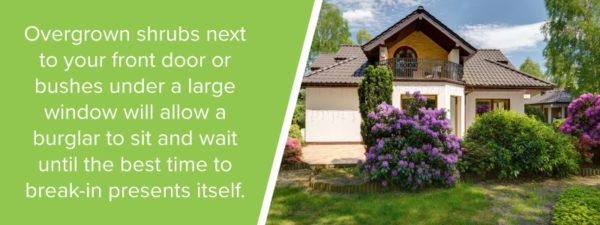
This doesn’t mean that you can’t landscape around your home. However, you’ll want to make sure that such landscaping is kept well-trimmed. You can even strategically place thorny bushes near access spots to make hiding painful.
Get to Know Your Neighbors
If you’re a stranger within your neighborhood, there’s a good chance that your neighbors don’t pay much attention to your home. That means that if something is amiss, they likely won’t notice.
That’s one of the reasons it’s a good idea to be friendly with your neighbors. You don’t need to be best friends with them, but it’s helpful if they regularly see you around the house and the neighborhood. That way, if something suddenly changes, it will arouse their suspicion.
Don’t Leave Ladders and Other Useful Tools Sitting Out
Sophisticated burglars have tools that they use to gain entry to a home. However, if you leave tools sitting in your front yard overnight, even a less ingenious thief will have access to the tools of the burglary trade. So make sure to put that stuff away overnight, even if you anticipate using it again the next day.
Develop Patterns of Living That Won’t Change When You’re Away
Good thieves pick up on subtle changes and use that as evidence that someone is away on an extended trip. For example, if you typically leave your garage door open with the car inside when you are home, they may notice when your garage door is closed for a week and conclude that you are away.
That why you want to do things while you are home that won’t change when you are away. For example, if you have your lights on a timer when you are at home, it won’t look any different if the timer continues to run while you are away. The same is true of always closing your garage door whether you are home or not.
Automation tools are a great recent technological innovation that makes this process even easier. Because these tools are integrated into smart technology on a phone, computer or tablet, they give you unprecedented control of your home’s various systems and even alert you when something has changed. Because you can access these features anywhere around the world, it will be much easier to make your home feel occupied even if you aren’t there.
For more information on home automation, check out our product line of top-of-the-line smart security solutions.
Finally, have a friend or neighbor keep up the routines that can’t be automated. That means having someone pick up your mail and paper so that people don’t notice your mailbox filling up. If you’re going to be gone for an extended period, have someone mow the lawn as well, as a normally well-kept lawn that is suddenly overgrown is a sure sign that no one is home.
Invest in Good Locks
While technology is wonderful, it’s important that you also take the time to invest in high-quality physical deterrents. You want to do everything you can to make sure that a burglar won’t be able to put their shoulder into your front door and gain access even if it is locked.
It’s always a good idea to get the locks changed when moving into a new home. You never know how many spare keys may be floating around among friends and neighbors of the previous owners. When having your locks changed, make sure to ask the locksmith if the locks on all your doors are installed are properly and are suited for the door. If a previous owner installed the locks themselves, they may have done so improperly, so it’s good to have an expert opinion and make changes if necessary.
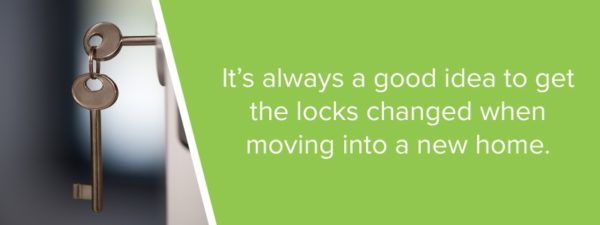
You also want to make sure that you have secondary locking defenses, in case you forget to lock the deadbolt or it fails.
Make sure that the door connecting your garage to the interior of your home has the same kinds of locks installed as all of your exterior doors. Burglars will sometimes take advantage of a weak garage door to gain access. If the door connecting the garage to the rest of the home is also weak, they will be able to easily bypass the more robust locks installed on your front door.
You might also add an extra layer of security to your sliding glass doors. Sliding glass doors — especially older models — are notoriously easy to break into, so you don’t want to rely on their standard security features.
Finally, make sure you aren’t neglecting the locks on your windows. If you have older windows, you may want to replace the locks. You can also invest in impact-resistant glass that will make it harder for a burglar to smash the window and then reach in and unlock it.
Invest in Smart Home Security
Finally, look to integrate technologies that are designed to make your home as secure as possible.
Fortunately, we are in the midst of an age of rapid technological development that can be applied to security solutions that were the stuff of science fiction just decades ago.
Motion detectors will alert you to anyone entering your home who isn’t supposed to be there. Video monitoring, whether on the interior of your house or at the front door, will let you know if someone is lurking outside or moving through your home while you’re away.
Burglar alarms will not only scare away intruders who set them off, but they will instantly inform you and local first responders of the need to send help.
Plus, since all these features are easily integrated into your smart phone through connected apps, you will be able to monitor and adjust your security measures whether you are on a tropical beach, traveling through Europe or just on a day trip to the city.
However, smart home security solutions are only as good as the security professionals who install and support them. That’s why you need a security partner that you can trust. Here at Lloyd Security, we specialize in high-tech security solutions for both residential customers and commercial applications.
With unrivaled professional support for our solutions, you can feel confident that you are getting the best solution for your home’s particular security needs while knowing that you are also gaining a partner committed to making sure that your security is robust and working exactly as intended.
If you want more information on how to best implement smart security solutions in your home, or if you are ready to start the process of securing your residence, contact us today!

